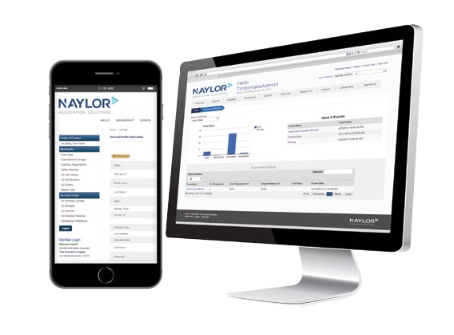What is Association Management Software?
Association management software (AMS), sometimes referred to as membership software, can be a daunting product to wrap your head around. There are so many options in the marketplace and so many different areas of functionality that association management software can improve – including your website, event registration, dues invoicing, online communities, reporting and more.
Combine these tasks with all the other responsibilities most association staff are required to spend day-to-day time on, and it becomes clear why it’s so easy to fall into the pattern of simply re-using whatever outdated or inefficient mechanisms are already in place.
But what is association management software, anyway?
And when does “it’s worked well enough for years” stop being good enough?
Here’s a brief explanation of what association management software really is, and some of the main reasons your association consider jumping in.
What is Association Management Software?
 Let’s begin by answering the first question about AMS – what is it? At its most basic level, an AMS is software that serves as the database of record for all of an association’s member data. It aggregates all the membership information an association collects and manages as it carries out the administrative and programming functions that further its mission. An AMS will also typically either integrate directly into your association’s website, or will in fact include its own website, so that members can engage with the association directly through the software using actions like registering for events, making a donation, and posting in an online forum.
Let’s begin by answering the first question about AMS – what is it? At its most basic level, an AMS is software that serves as the database of record for all of an association’s member data. It aggregates all the membership information an association collects and manages as it carries out the administrative and programming functions that further its mission. An AMS will also typically either integrate directly into your association’s website, or will in fact include its own website, so that members can engage with the association directly through the software using actions like registering for events, making a donation, and posting in an online forum.
Association Management Software Saves Members and Staff Time
From your staff’s perspective, using an AMS to manage membership data can save precious time. Before considering an AMS, most associations use multiple vendors or products for their technology needs – one for their website, one to organize event registrations, one for handling member profiles, and another for managing invoices for member dues. Vendor relationships take time to manage, and when you’re contracting with multiple vendors, your staff might find itself regularly on the phone trying to problem-solve the latest breakdown in functionality for any given system. Having a business relationship with one support staff who knows their company’s product and how it integrates with other systems (such as a credit card processor or website vendor) can save plenty of support minutes in the long run.
From a member’s perspective, an AMS offers the ability to self-service on the members-only section of the website for issues like updating their profile information online or viewing/printing receipts and invoices. Most of your association’s members have jobs that likely share office hour overlap with your association, so giving the ability to view and modify information on their own schedule adds convenience for your members. It also makes it more likely that all their information will be up to date because they don’t have to plan out a call or visit; they can simply access their record whenever it occurs to them. If a member has to jump through hoops to help you keep your data correct, you’re probably not working with the most correct data possible – and it’s probably time to take a look at AMS options.
Association Management Software Breaks Down Data Silos

Apart from the obvious downside of having to juggle multiple technology interfaces and vendor relationships, storing data in multiple systems has the negative effect of keeping your association’s data in separated “silos.” This means that each area of data is completely isolated, unable to interact with (or update) data in other systems. How do information silos work against you? Let’s say a member wants to change his or her address and calls to let you know the new address. With their information residing in multiple systems that govern your mailing list, your events, your volunteer database, and so forth, simply updating their member profile in one system won’t be enough. The address will still be incorrect in all the other systems until each someone (or someones) on your team update each system individually. That is, if the new information is passed on to the appropriate person as it should be, and if each point person updates the system in time for the new information to be useful.
Having to enter the same information in multiple silos also increases the chances that someone will accidentally miss a keystroke or leave out a piece of the update, creating the problem of multiple records for the same member that don’t match up. How will your staff know which record is correct? Human error happens even with the most diligent employees. By bringing your association’s disparate data systems together onto one AMS platform, you get a single point of record for all your member data. All your mailing lists are updated at once. All your member demographics are updated across the board with fewer potential for mistakes. The result is not only saving staff time from multiple manual updates, but also more complete and accurate information that is less likely to conflict or be incomplete. If you’re struggling with too many errors or missed data points across your data systems, that’s another sign it’s time to see what an AMS can do for your association.
Association Management Software Offers Improved Reporting Over Basic Spreadsheets
 The consolidation of multiple systems also streamlines the process of reporting. Everyone wants for their association’s operations and programming to improve over time, but it’s difficult to improve anything without fully understanding it first, and your member data is no exception.
The consolidation of multiple systems also streamlines the process of reporting. Everyone wants for their association’s operations and programming to improve over time, but it’s difficult to improve anything without fully understanding it first, and your member data is no exception.
Improving your understanding of your association’s offerings may be easy enough when you’re dealing with a single data point; for example, if you want more engaging emails, you need to see how many people are opening and interacting with each email to see which content produces the most engagement.
But what if you also want to know how many foundation donors also read your emails? This is where an AMS really shines: compiling reports across multiple data points. Let’s say you’d like to see how many of your prospective members attended at least two events this year, made a donation, and are subscribed to at least one of your online newsletters. This subgroup could represent ideal targets for membership and an AMS can quickly provide that information for you to form the foundation for an outreach campaign. If the thought of how you’d be able to get that kind of information at a moment’s notice with your current systems gives you anxiety, an AMS might put your mind at ease.
Association Management Software Automates Mundane Tasks So You Can Focus on the Important Stuff
Keeping with the theme of making things simpler for your staff, an AMS automates the basic administrative tasks that might otherwise take up staff or volunteer time. Invoice generation, dues reminder emails, event registration and confirmation emails, and restricting access to members-only areas of the website as soon as a member expires are just a few examples of communications and confirmations that an AMS can automatically generate or trigger. Even with a small membership, repetitive, ongoing tasks can involve a fair amount of dedicated staff time; and as we explored earlier, there’s always the risk of a user error preventing a member from receiving a needed piece of communication or receiving the wrong information – which makes for a less-than-ideal member experience. Automation from an AMS ensures consistency, correct information, and significantly less dedicated personnel time to implement. If your staff is spending too much time on basic administrative functions and not enough time serving your members and helping grow the association, an AMS can take over those necessary routine tasks to help you focus on what’s most important.
Association Management Software Helps You Stay Mission-Focused
A search for new software is a big step for an association, and while it represents change and a potentially intimidating process, it’s often necessary to keep your association mission-focused. Members today are driven by changing technology in all other areas of their lives, so their expectations for association interactions are evolving as well. An AMS provides your association the technological infrastructure for an enhanced member experience, while at the same time taking care of a lot of behind-the-scenes administrative activities, which frees up your staff to attend to more critical operational matters.
But what if you also want to know how many foundation donors also read your emails? This is where an AMS really shines: compiling reports across multiple data points. Let’s say you’d like to see how many of your prospective members attended at least two events this year, made a donation, and are subscribed to at least one of your online newsletters. This subgroup could represent ideal targets for membership, and an AMS can quickly provide that information for you to form the foundation for an outreach campaign. If the thought of how you’d be able to get that kind of information at a moment’s notice with your current systems gives you anxiety, an AMS might put your mind at ease.
Not sure how to get started? Check out our checklist or webinar about how to keep implementing software from becoming a PITA: Pain in the Association!


